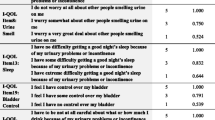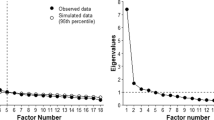Abstract
Introduction
The 33-item Overactive Bladder questionnaire (OAB-q; 1-week recall version) has been psychometrically validated in middle-aged, generally healthy patients with overactive bladder. The present analysis was conducted to determine the psychometric validity of the OAB-q in medically complex elderly patients.
Methods
OAB-q structure was evaluated using a second-order confirmatory factor analysis (CFA) model with five domains and one aggregated domain, using pooled data from two clinical trials (786 observations) for urgency urinary incontinence (UUI). Psychometric validity was evaluated with CFA, Cronbach coefficient α (CCA) for reliability, Spearman correlations for convergent validity, differences in OAB-q scores in relation to UUI severity and Patient Perception of Bladder Condition (PPBC) scores for known-groups validity, and effect size (ES) of differences in mean scores of OAB-q domains over time for treatment responsiveness.
Results
Participants were predominantly female (82.2%) and white (85.9%); mean age was 75.0 years. The second-order CFA was confirmed with a Bentler’s comparative fit index of 0.90, t values for path coefficients of >1.96, and standardized path coefficients of >0.40. OAB-q domains demonstrated good internal consistency (CCA >0.7). Convergent validity was supported by moderate correlations (0.4–0.7) between OAB-q domain and PPBC scores. Significant differences in OAB-q domain scores between groups with different symptom severity established known-groups validity. Significant changes in mean OAB-q scores from baseline to week 12 with moderate-to-large ES (0.50–0.80) demonstrated treatment responsiveness.
Conclusions
The OAB-q demonstrates reliability, concurrent and discriminant validity, and responsiveness to treatment. The evidence shows that the OAB-q is psychometrically sound for use in medically complex elderly patients with overactive bladder.



Similar content being viewed by others
References
Abrams P, Cardozo L, Fall M et al. The standardisation of terminology of lower urinary tract function: report from the Standardisation Sub-committee of the International Continence Society. Am J Obstet Gynecol. 2002;187:116–126.
Liberman JN, Hunt TL, Stewart WF et al. Health-related quality of life among adults with symptoms of overactive bladder: results from a U.S. community-based survey. Urology. 2001;57:1044–1050.
Irwin DE, Milsom I, Kopp Z, Abrams P, Cardozo L. Impact of overactive bladder symptoms on employment, social interactions and emotional well-being in six European countries. BJU Int. 2006;97:96–100.
Coyne KS, Sexton CC, Kopp ZS, Ebel-Bitoun C, Milsom I, Chapple C. The impact of overactive bladder on mental health, work productivity and health-related quality of life in the UK and Sweden: results from EpiLUTS. BJU Int. 2011;108:1459–1471.
Helfand BT, Evans RM, McVary KT. A comparison of the frequencies of medical therapies for overactive bladder in men and women: analysis of more than 7.2 million aging patients. Eur Urol. 2010;57:586–591.
Irwin DE, Milsom I, Hunskaar S et al. Population-based survey of urinary incontinence, overactive bladder, and other lower urinary tract symptoms in five countries: results of the EPIC study. Eur Urol. 2006;50:1306–1314. discussion 1314-5.
Coyne KS, Sexton CC, Vats V, Thompson C, Kopp ZS, Milsom I. National community prevalence of overactive bladder in the United States stratified by sex and age. Urology. 2011;77:1081–1087.
Chancellor MB, de Miguel F. Treatment of overactive bladder: selective use of anticholinergic agents with low drug-drug interaction potential. Geriatrics. 2007;62:15–24.
Delafuente JC. Understanding and preventing drug interactions in elderly patients. Crit Rev Oncol Hematol. 2003;48:133–143.
Gibson W, Athanasopoulos A, Goldman H et al. Are we shortchanging frail older people when it comes to the pharmacological treatment of urgency urinary incontinence? Int J Clin Pract. 2014;68:1165–1173.
U.S. Department of Health and Human Services. Guidance for Industry. Patient-Reported Outcome Measures: Use in Medical Product Development to Support Labeling Claims. Silver Spring, MD: U.S. Department of Health and Human Services, Food and Drug Administration; 2009.
Cappelleri JC, Zou KH, Bushmakin AG, Alvir JMJ, Alemayehu D, Symonds T. Patient-reported outcomes: measurement, implementation and interpretation. Boca Raton: Chapman & Hall; 2013.
Saliba D, Elliott M, Rubenstein LZ et al. The Vulnerable Elders Survey: a tool for identifying vulnerable older people in the community. J Am Geriatr Soc. 2001;49:1691–1699.
Coyne K, Revicki D, Hunt T et al. Psychometric validation of an overactive bladder symptom and health-related quality of life questionnaire: the OAB-q. Qual Life Res. 2002;11:563–574.
Coyne KS, Matza LS, Thompson CL. The responsiveness of the Overactive Bladder Questionnaire (OAB-q). Qual Life Res. 2005;14:849–855.
Coyne KS, Gelhorn H, Thompson C, Kopp ZS, Guan Z. The psychometric validation of a 1-week recall period for the OAB-q. Int Urogynecol J. 2011;22:1555–1563.
Coyne KS, Matza LS, Kopp Z, Abrams P. The validation of the patient perception of bladder condition (PPBC): a single-item global measure for patients with overactive bladder. Eur Urol. 2006;49:1079–1086.
Coyne KS, Margolis MK, Hsieh R, Vats V, Chapple CR. Validation of the urinary sensation scale (USS). Neurourol Urodyn. 2011;30:360–365.
Wagg A, Khullar V, Marschall-Kehrel D et al. Flexible-dose fesoterodine in elderly adults with overactive bladder: results of the randomized, double-blind, placebo-controlled study of fesoterodine in an aging population trial. J Am Geriatr Soc. 2013;61:185–193.
DuBeau CE, Kraus SR, Griebling TL et al. Effect of fesoterodine in vulnerable elderly subjects with urgency incontinence: a double-blind, placebo controlled trial. J Urol. 2014;191:395–404.
Coyne KS, Matza LS, Thompson CL, Kopp ZS, Khullar V. Determining the importance of change in the overactive bladder questionnaire. J Urol. 2006;176:627–632. discussion 632.
Abrams P, Artibani W, Gajewski JB, Hussain I. Assessment of treatment outcomes in patients with overactive bladder: importance of objective and subjective measures. Urology. 2006;68:17–28.
Acknowledgements
The authors thank Tara Symonds and Doug Chapman for their contributions to the protocol development and early involvement in this analysis.
Author information
Authors and Affiliations
Corresponding author
Ethics declarations
Funding
This study was sponsored by Pfizer Inc. Medical writing assistance was provided by Patricia B. Leinen, PhD, of Complete Healthcare Communications, LLC (Chadds Ford, PA), a CHC Group company, and was funded by Pfizer Inc.
Conflicts of Interest
None.
Electronic supplementary material
Below is the link to the electronic supplementary material.
ESM 1
(DOCX 240 kb)
Rights and permissions
About this article
Cite this article
Barsdorf, A.I., Carlsson, M., Bushmakin, A.G. et al. Validation of overactive bladder questionnaire (1-week recall version) in medically complex elderly patients with overactive bladder. Int Urogynecol J 28, 1857–1863 (2017). https://doi.org/10.1007/s00192-017-3305-8
Received:
Accepted:
Published:
Issue Date:
DOI: https://doi.org/10.1007/s00192-017-3305-8




